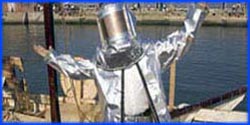


Premier Date: March 1, 2014
busted
Adam and Jamie began by hitting balls by hand with a paddle and achieved a maximum speed of 75 mph (121 km/h). Adam built a compressed-air launcher and got the ball up to 140 mph (230 km/h) at a pressure of 95 psi (660 kPa). Jamie commented that a longer barrel would allow more time for the air pressure to accelerate the ball. Using an 80 ft (24 m) barrel and a pressure of 140 psi (970 kPa), they reached 453 mph (729 km/h)—fast enough to punch through the target board and leave a mark on its plywood backstop.
Adam researched a method for accelerating the ball by placing it in a sealed tube, evacuating all the air, and puncturing the seal on the end behind the ball. Using a 3 ft (91 cm) tube, he found that the ball burst out the other end in excess of 300 mph (480 km/h). Increased lengths led to a higher top speed within the barrel, but caused the ball to slow down before leaving the barrel due to resistance from the air accumulating in front of the ball. However, Adam learned of a modification that involved adding a choke chamber to the far end in order to pop the seal and give the ball an extra burst of speed. With the choke in place, he and Jamie measured a speed of 779 mph (1,254 km/h) out of the barrel.
In a hangar at Fort Mason, they set up their vacuum launcher with a 150 ft (46 m) barrel and a 500 psi (3,400 kPa) air supply. Their first launch measured 1,086 mph (1,748 km/h), but the ball broke into fragments before it left the barrel; a second test, at 20 ft (6.1 m) length and 300 psi (2,100 kPa), gave 1,100 mph (1,770 km/h), left the ball intact, and allowed it to smash a hole through a ping-pong paddle. For a test of lethal potential, they fired at a slab of pork, which fell off its support hook on impact and was found to have a 1.5 in (3.8 cm) deep hole. They classified the myth as busted, noting that the wound would be serious but not fatal.
busted
The Build Team crafted ice cannonballs with four different reinforcements mixed in: none, hemp fiber, sawdust, and paper fiber. They loaded the un-reinforced ball into a Civil War-era cannon with 8 oz (230 g) of black powder and fired it at a target dummy; the ball remained intact, achieving a speed of 684 mph (1,101 km/h) and scoring a knockdown. A test with 24 oz (680 g) of powder, the largest charge the cannon could take, also left the ball intact and gave a top speed of 1,550 mph (2,490 km/h). They chose to use the un-reinforced balls for all further testing.
Tory built three cannon breeches out of ice, with different wall thicknesses for strength testing. When the team loaded the 8 in (20 cm) thick breech with 8 oz (230 g) of powder and set it off, the blast destroyed the breech; subsequent tests with charges up to 1.75 oz (50 g) left the breech intact, though. They then built a complete cannon and set up targets at 150 yards (140 m) in order to evaluate three criteria: range, damage potential, and reusability. Their first shot reached a speed of 200 mph (320 km/h) and covered the distance to the target zone, but did not hit any targets. A second test, with the angle adjusted to fire over the targets’ heads, caused the cannon to shatter. The team judged the myth as busted, since the cannon had met only the first two of their three criteria.
(This myth was based on claims that an army in 18th-century Russia used such a weapon to defend itself.)
Previous: Episode 214: Bullet Baloney